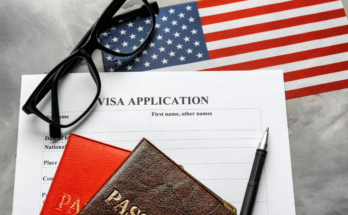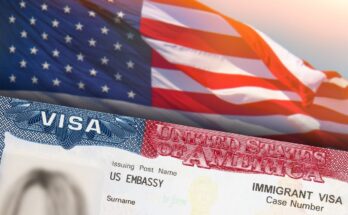The United States offers numerous opportunities for immigrants seeking to work and build a career. However, to legally work in the country, you’ll often need a work visa, typically obtained through employer sponsorship.
This sponsorship process is essential because it involves a U.S.-based employer taking responsibility for your job offer and supporting your application for legal employment status.
Let’s dive deeper into how the work visa system works and explore various options available to aspiring immigrants.
Types of USA Work Visas
Temporary Work Visas (Non-Immigrant Visas)
Temporary work visas allow individuals to work in the U.S. for a limited period under specific job categories. Common types include:
- H-1B Visa: Popular among professionals in tech, engineering, and healthcare, this visa requires specialized skills and qualifications.
- L-1 Visa: Enables employees of multinational companies to transfer to U.S. offices.
- O-1 Visa: Designed for individuals with extraordinary talent in arts, science, education, or athletics.
- TN Visa: Available to citizens of Canada and Mexico under NAFTA.
These visas often have specific application windows, quotas, and eligibility requirements.
Permanent Work Visas (Immigrant Visas)
Permanent work visas, also known as employment-based green cards, offer a path to long-term residence in the U.S. Major categories include:
- EB-1: For individuals with exceptional skills or achievements in their field.
- EB-2: For professionals with advanced degrees or extraordinary abilities.
- EB-3: For skilled, unskilled, and professional workers.
These visas typically take longer to process but provide a pathway to U.S. citizenship.
What is Visa Sponsorship?
Visa sponsorship refers to the process where a U.S. employer supports a foreign worker’s application to obtain a legal work visa. This sponsorship confirms that the employer has a valid job offer and is willing to comply with U.S. immigration laws. Sponsorship is crucial since many visa categories require it as part of the eligibility criteria.
Employers must meet various requirements to sponsor a worker, including demonstrating that no qualified U.S. citizens are available for the role. For workers, sponsorship can open doors to valuable job opportunities and long-term career growth in the U.S.
Requirements for Visa Sponsorship
Employer Requirements
For an employer to sponsor a work visa, they must:
- Provide a legitimate job offer that aligns with the visa’s requirements.
- File necessary paperwork, such as labor condition applications (LCA) for H-1B visas.
- Demonstrate that hiring a foreign worker will not negatively impact U.S. workers’ wages and conditions.
Applicant Requirements
Applicants need to meet specific criteria based on the visa type. These typically include:
- Relevant work experience and educational qualifications.
- Clean legal and immigration history.
- Submission of required documents, such as a resume, employment contracts, and certifications.
Meeting both employer and applicant requirements ensures a smoother visa approval process.
Popular Work Visa Programs in the USA
H-1B Visa Program
The H-1B visa is one of the most sought-after options for skilled professionals. It’s widely used by tech companies and offers a renewable three-year period, with a cap of 85,000 visas issued annually. The demand for H-1B often exceeds supply, leading to a lottery system for selection.
L-1 Visa for Intracompany Transfers
The L-1 visa benefits employees of multinational corporations who need to transfer to a U.S. office. It is ideal for managers, executives, or specialists and allows for family members to accompany the worker on L-2 visas.
O-1 Visa for Individuals with Extraordinary Ability
This visa caters to individuals recognized for excellence in their profession. Artists, scientists, athletes, and others who can demonstrate significant achievements are eligible.
EB-3 Visa for Skilled and Unskilled Workers
The EB-3 visa is an attractive option for both skilled professionals and unskilled workers. It accommodates various roles, including positions in industries like construction, manufacturing, hospitality, and healthcare. While skilled roles require documented training or experience, unskilled roles may not demand extensive qualifications.
Applicants under this category may face longer wait times due to the visa’s popularity, but it remains a viable pathway to permanent residence in the U.S. Since it offers a green card, many workers consider the EB-3 visa a strong long-term career option.
Application Process for a USA Work Visa
Applying for a U.S. work visa involves several stages. Here’s a step-by-step guide:
- Job Offer and Sponsorship:
You’ll need a U.S. employer willing to sponsor your visa. They must provide a job offer and start the necessary paperwork. - Filing the Petition:
The employer files a petition on your behalf with U.S. Citizenship and Immigration Services (USCIS). This step is crucial for visa categories like the H-1B, where the petition establishes your eligibility. - Labor Certification (if required):
For some visas, such as the EB-3, the employer must obtain a labor certification to prove there are no qualified U.S. workers available for the role. - Submitting Your Visa Application:
Once the petition is approved, you’ll need to apply for the visa through the U.S. embassy or consulate in your home country. This step includes filling out forms, paying fees, and scheduling an interview. - Visa Interview:
The interview is a key part of the process. You’ll need to provide evidence of your qualifications, employment offer, and other supporting documents. - Approval and Entry:
If approved, you’ll receive your visa and can travel to the U.S. Upon arrival, you’ll go through customs, where your work authorization will be confirmed.
Processing Time for USA Work Visas
Visa processing times vary depending on the type of visa and individual circumstances. Here’s an overview:
- H-1B Visa: Processing can take anywhere from a few months to over a year due to the annual cap and lottery system. Premium processing is available for expedited service.
- L-1 Visa: Processing times typically range from several weeks to a few months.
- Employment-Based Green Cards: The wait time can extend to several years, especially for applicants from countries with high demand, like India and China.
Delays may occur due to incomplete documentation, high application volumes, or additional background checks.
Challenges and Common Issues
High Demand and Limited Quotas
Certain visas, like the H-1B, face overwhelming demand each year. With only 85,000 slots available and thousands of applications submitted, many qualified candidates are left without visas due to the lottery system. This high competition can discourage applicants, but persistence and early preparation can improve your chances.
Rejections and Denials
Visa applications can be denied for various reasons, including:
- Incomplete or inaccurate paperwork.
- Lack of proper qualifications.
- Issues with the employer’s petition.
To minimize the risk of rejection, ensure all documentation is complete and seek legal assistance if needed.
Visa Renewal and Extensions
Work visas have expiration dates, and maintaining legal status requires timely renewal or extension. For instance, the H-1B visa is initially granted for three years but can be extended for an additional three years. Failure to renew on time can result in legal consequences, including deportation.
How to Find Employers Offering Visa Sponsorship
Industries with High Sponsorship Opportunities
Certain industries in the U.S. are more likely to offer visa sponsorship due to labor shortages and specialized skill requirements. These industries include:
- Information Technology (IT)
- Healthcare (nurses, doctors, medical specialists)
- Engineering (civil, mechanical, software)
- Education (teachers, professors)
- Finance and Accounting
These fields often rely on global talent and actively recruit qualified immigrants.
Online Job Portals for Sponsored Positions
Numerous job portals specialize in listing opportunities that include visa sponsorship. Popular platforms include:
- LinkedIn: Search for jobs by filtering for sponsorship opportunities.
- Indeed: Use keywords like “visa sponsorship” to find relevant listings.
- Glassdoor: Browse company reviews and job listings that specify sponsorship availability.
Job boards dedicated to immigrants, such as MyVisaJobs and H1BGrader, are also valuable resources.
Networking and Recruitment Events
Building relationships with professionals and recruiters can significantly increase your chances of finding a sponsor. Attend career fairs, industry conferences, and networking events. Additionally, reaching out to recruiters on platforms like LinkedIn can help you discover hidden opportunities.
Costs Associated with Visa Sponsorship
Visa sponsorship involves various costs that may be shared between the employer and employee. Typical expenses include:
- Application Fees: Paid to USCIS and other government agencies.
- Attorney Fees: Many employers hire immigration lawyers to handle paperwork.
- Premium Processing: An optional service to expedite visa processing.
Employers are legally required to cover certain costs, such as labor certification fees for H-1B applicants, but workers may need to cover other expenses like travel and medical exams.
Rights and Responsibilities of Sponsored Workers
Sponsored workers are entitled to certain rights under U.S. labor laws, including:
- Fair Wages: Employers must pay at least the prevailing wage for the job.
- Safe Work Environment: Workers have the right to a safe, harassment-free workplace.
- Access to Benefits: Sponsored workers are often eligible for health insurance, retirement plans, and other benefits.
However, workers must also adhere to visa conditions, such as maintaining valid employment and notifying USCIS of any changes to their status.
Alternatives to Employer-Sponsored Work Visas
Self-Petitioned Visas
Certain visa categories allow applicants to sponsor themselves without an employer. Examples include:
- EB-1A: For individuals with exceptional achievements.
- National Interest Waiver (NIW): For professionals whose work benefits the U.S.
These visas are ideal for highly accomplished individuals seeking more independence.
Student and Exchange Visitor Visas (F and J Visas)
Many immigrants start their journey in the U.S. as students or exchange visitors. These visas allow for work authorization through programs like:
- Optional Practical Training (OPT) for F-1 students.
- Academic Training (AT) for J-1 exchange visitors.
Graduates often transition to work visas with the help of employer sponsorship.
Benefits of Obtaining a Work Visa
Securing a U.S. work visa offers numerous benefits, including:
- Career Growth: Access to high-paying and prestigious roles in leading industries.
- Permanent Residency Pathway: Many work visas lead to green card eligibility.
- Family Benefits: Dependents can often join workers and access education and healthcare.
These opportunities make the U.S. an attractive destination for skilled professionals worldwide.
Recent Changes and Updates to Visa Policies
U.S. immigration policies are subject to change based on political and economic factors. Recent developments include:
- Increases in visa caps for high-demand categories.
- New initiatives to attract STEM talent.
- Enhanced scrutiny of visa petitions to prevent fraud.
Staying informed about policy changes is crucial for applicants and employers alike.
Tips for a Successful Work Visa Application
- Start Early: Application windows can close quickly, especially for capped visas.
- Double-Check Documents: Ensure all forms and evidence are complete.
- Seek Expert Advice: Consult an immigration lawyer or expert if you’re unsure about any aspect of the process.
With careful planning and preparation, you can maximize your chances of success.
Conclusion
The journey to obtaining a U.S. work visa can be complex but rewarding. By understanding the types of visas, sponsorship requirements, and application processes, you can take significant steps toward achieving your career goals in the United States. Don’t let the challenges deter you—opportunities abound for those who persevere.



